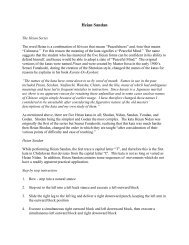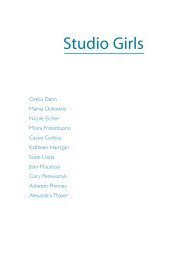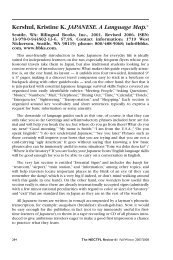selected paintings - Dickinson College
selected paintings - Dickinson College
selected paintings - Dickinson College
Create successful ePaper yourself
Turn your PDF publications into a flip-book with our unique Google optimized e-Paper software.
2<br />
Industrial Quarter, n.d.<br />
Oil on canvas, 23 1/2 x 28 1/2 in. (59.7 x 72.4 cm)<br />
Signed: l.l.: Quincy<br />
Exhibited: Spirit of the Past: The Paintings of Edmund Quincy, 1903-1997 (New<br />
York: Hirschl & Adler Galleries, 2000).<br />
Published: Zachary D. Ross, Spirit of the Past: The Paintings of Edmund Quincy,<br />
1903-1997 exh. cat. (New York: Hirschl & Adler Galleries, 2000), 38,<br />
cat. 50.<br />
Courtesy of Hirschl & Adler Galleries, NYC<br />
Suburban life is celebrated in Edmund Quincy’s painting,<br />
Industrial Quarter. The contemporary urban landscape depicted<br />
in this painting has similar imagery to that found in his other<br />
work, Background of Metropolitan Industry. Both <strong>paintings</strong> suggest<br />
an “intimate viewpoint” and the immediate surroundings<br />
of everyday suburban life. 1 The imagery in both of these <strong>paintings</strong><br />
suggests a juxtaposition of suburban life and industrialization<br />
with depictions of suburban buildings and quiet landscapes.<br />
Unlike the Background of Metropolitan Industry, the<br />
imagery in Industrial Quarter addresses urban life in the suburban<br />
town directly, placing the industrial buildings in the foreground<br />
and addressing them as one of the main subjects of the<br />
painting. However, in Background of Metropolitan Industry, the<br />
imagery of urban life is represented in the background by industrial<br />
buildings and is not the main focal point. The industrial<br />
and suburban images in Industrial Quarter have pictorial significance<br />
essential to Quincy’s painting.<br />
Quincy, like other American painters Edward Hopper and<br />
Charles Burchfield, illustrates a typical American scene evoking<br />
an industrial street scene. After the end of World War II,<br />
America expanded and, as Zachary Ross stated, “the fabric of<br />
urban America became increasingly de-centralized.” 2 Lloyd<br />
Goodrich remarked about Edward Hopper that, “opposite of<br />
the general trends of modernism: instead of subjectivity, a new<br />
kind of objectivity; instead of abstraction, a purely representational<br />
art.” 3 Hopper’s representational art can be seen in his<br />
painting, East Wind over Weehawken (1934), where a contemporary<br />
urban life is depicted. Like Hopper’s painting, the representation<br />
of urban life can also be seen in Quincy’s Industrial<br />
Quarter. Due to the vast amount of pictorial possibilities that<br />
can be drawn upon to depict an industrial suburban scene, both<br />
Quincy and Hopper present the visual material with pictorial<br />
significance. Quincy’s Industrial Quarter embodies essential elements<br />
found within both suburban lifestyle and within industrial<br />
urban lifestyles. These elements in Quincy’s Industrial<br />
Quarter are industrial buildings, lampposts, telephone poles,<br />
cement sidewalks, a paved road, picket fence, maternal home,<br />
and a “human presence.”<br />
Quincy’s Industrial Quarter is compositionally centered by<br />
an empty paved road traveling into the distance. Writing about<br />
Hopper, Margaret Iverson suggested that “uninterrupted horizontal<br />
lines make the viewer conscious of the space beyond the<br />
8<br />
limits of the scene.” 4 The empty road traveling into the distance<br />
is a visual construct also found in Hopper’s painting,<br />
Manhattan Bridge Loop (1928). In this image, an empty road<br />
traveling into the distance is also the center of the composition.<br />
Both a telephone pole and a lamppost balance the industrial<br />
setting of Quincy’s painting. These elements of an industrial<br />
setting compositionally add vertical balance on either side of the<br />
diagonal road. These two objects also suggest the industrial period<br />
found in the suburban street scene. The verticals in the lampposts<br />
are not entirely vertical and lean in different directions,<br />
which is another characteristic found in Hopper’s painting entitled<br />
Manhattan Bridge Loop. As in the work by Hopper, horizontals<br />
provide the foundation for the structure and as noted by<br />
Goodrich, “are crossed and interpreted by strong verticals.” 5<br />
Also similar to the composition in Hopper’s painting is<br />
Quincy’s use of verticality which is a dominant compositional<br />
element also found in Industrial Quarter. The verticality is illustrated<br />
through the angular industrial buildings, the telephone<br />
pole, lamppost, and fence. The diagonal road breaking up the<br />
composition divides the suburban life depicted on the left from<br />
industrial buildings depicted on the right. The industrial buildings<br />
are dominant elements of the scene in both color palette<br />
and size.<br />
The vibrant palette in rich colors of salmon, red, and<br />
bright yellows depicts the large industrial buildings. On the<br />
opposite side of the road, a warm, rich palette is juxtaposed by<br />
rich shades of blue, brown, and green. The juxtaposition of colors<br />
competes with one another from the respective sides of the<br />
painting. The rich shades depicted in the trees and home on the<br />
left of the diagonal road emphasize Quincy’s application of<br />
paint. The loose brushstrokes in the panels and roof of the<br />
house suggest <strong>paintings</strong> by Degas, such as Ballerine en Rose<br />
(1890). In Degas’ painting, the brushstrokes are evident in the<br />
ballerina’s tutu, strokes which are similarly evident in the house<br />
found on the left-hand side of the foreground of Industrial<br />
Quarter. While Quincy is not an “impressionist” painter like<br />
Degas, his brushstrokes are much more vivid in the house than<br />
those of the flat application of paint found in the industrial<br />
buildings on the other side of the diagonal road. The earth<br />
tones in the diagonal road are painted using diagonal brushstrokes,<br />
creating a sense of vertical movement throughout the<br />
image. This vertical movement can also be seen in Degas’<br />
Ballerine en Rose in the tutu. The application of paint on the<br />
right-hand side of the composition creates a solid surface with<br />
little to virtually no movement at all.<br />
It can be suggested that the light in this scene reveals the<br />
“character” of the buildings. Quincy’s application of light shadows<br />
suggests the individual forms of buildings and their surfaces.<br />
The shadows cast from the sun create the sharp angles of<br />
the buildings as well as diagonal movement. Similar to Quincy’s<br />
other work, A Shady Street, movement is created through light.<br />
Shadows from the sun are cast on the roads in both <strong>paintings</strong>.






